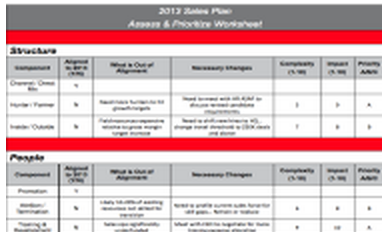You got a shit load of stuff to do, we get it. You’ve got to finalize the sales strategy, you have to roll out the new comp plan. Your expanding into Europe. The North America territory is being realigned. A new product roll out is designated for Q3. Your regional V.P. in the west is quitting. You’re Q1 numbers are down and you’re trying to secure a new channel partner. You’re busy and you’re asking yourself, how do I stay productive and not get crushed under that weight of everything.
Getting results is your job. You’re the Chief Sale Office/Executive Vice President of Sales; there is no room for failure in your world. But, man can it feel like there just isn’t enough time in the day, week or month to get done what needs to get done in order to deliver. To win in the this world you have to have a killer productivity and execution methodology that starts with knowing what is important and what isn’t.
I know, you’re gonna tell me that it’s all important. Yeah, yeah, I know. Everything is important, but the truth is it’s all individually important, but when initiatives are compared to one another, some rise to the top. Think Maslow’s Hierarchy of Needs. Companionship, friends, etc. are very important, but not if you haven’t eaten in a week. The same “hierarchy” applies to productivity and getting things done. Some things are just more important than others and knowing which ones to focus on is the key to productivity and execution.
Remember, 7 Habits of Highly Successful People? Think big rocks, little rocks.
The best way to figure out what’s most important is to categorize your initiatives into one of 4 categories based on their complexity to complete and the impact to the organization;
- High Impact to the organization, low complexity to complete
- High Impact to the organization, high complexity to complete
- Low Impact to the organization, low complexity to complete
- Low Impact to the organization, high complexity to complete
High Impact to the Organization, Low Complexity to Complete
These initiatives are the sweet spot, the bomb, the for real initiatives you should be working on first, before anything else. Why? Because their return on effort is so big. Your job is to deliver. Any initiatives that can deliver big results with little effort are key initiatives. Don’t delay, ignore everything else and jump on these initiatives first.
High Impact to the Organization, High Complexity to Complete
These initiatives are critical too. Their impact to the organization is big. The difference is they can take time. They can be difficult to execute, there is room for error etc. High complexity opportunities with big impact can have a high return, but they require lots of attention, time, effort and flexibility to deliver. Trying to do these first is a mistake. Get the easy ones out of the way, then attack this big hairy suckers. But whatever you do, do em! Just ’cause they’re hard doesn’t mean you can put them off. They’re gonna have big impact, they need to get done.
Low Impact to Organization, Low Complexity to Complete
These initiatives or tasks are annoying, BUT they are easy to get out of the way. They can be things like generating reports, approving expense reports, taking a vendor sales call etc. These things don’t create huge impact to the organization, but only take a little bit of time and effort, so they worth getting out of the way. Be sure to NOT let these get in the way of your more complex, bigger impact initiatives. It’s easy to do, thinking you can just knock them out, but you can’t. They will consume you if you let them. The problem is, despite being simple, they deliver very little return to the organization and making your number.
Low Impact to Organization, High Complexity to Complete
Stay away from these tasks and initiatives at all costs. They will eat you alive. High complexity initiatives and tasks take lots of time, resources and energy to complete. Spending time on them when they don’t provide a decent return is a death sentence to any and all the other initiatives that need to get done. These types of initiatives are often passed down from above or over from other departments. Don’t accept them. If it’s from above, do everything you can to demonstrate the LACK of impact the effort will have and how it will affect the rest of the organization. Don’t wast a minute on high complex initiatives with low impact to the organization, you’ll be wasting everyone’s time.
Productivity is more than just todo lists and being organized. There is an strategic element too. The strategy is in your ability to know what initiatives to focus on first and which to do next. Working on the wrong things can slay any productivity and undermine potential opportunities.
I use this tool with our clients to help them identify the efforts they should be working on and which can wait. It’s a scoring system that measures both the complexity of the initiative and the impact it will have on the sales organization and prioritizes them. Feel free to download it here.



